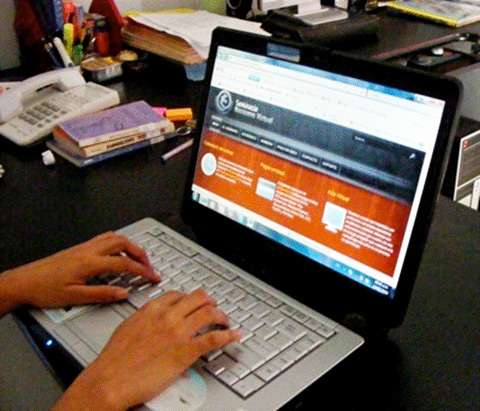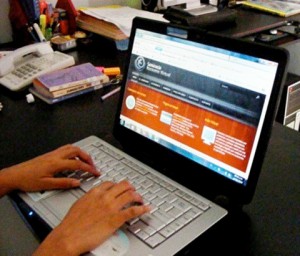Theological Education Through Interactive Technologies: Scenes of Present/Future Learning – by Meri MacLeod, PhD
Technology is changing the way we learn.
Technology is changing the way people of all ages learn. Research shows that as people engage information technologies it is changing their mental processes and the physical structure of their brains. A globally connected world is making new demands on academy graduates in all fields. There is a growing conviction among informed leaders in the academy that the standard educational model must be fundamentally changed. Inquiry-based learning with the blend of interactive and mobile technologies is understood as essential for the kind of critical thinking, problem-solving, collaborative work, and deep learning that is required for every field in the 21st century, including ministry leadership. A national 2010 research analysis of educational practices concluded that “just giving today’s students a better factory-era school, with teachers delivering text-based instruction in stand-alone classrooms won’t prepare them for the 21st century.”[1]
Through the selective use of interactive technologies chosen to support learning goals, seminaries can design educational models that achieve greater learning and make seminary available for many others. Contrary to misperceptions by seminary faculty, blending interactive technologies with on-campus and distance formats can actually strengthen student learning without the loss of significant relationships, spiritual formation, or institutional identity and values. This is the new opportunity before every seminary – enhanced student learning through appropriate application of interactive technologies whether on-campus or online.
As residential enrollment declines, online programs grow.
Residential enrollment has been in decline for some time across North American seminaries. Within the academy, residential enrollment largely remains overall flat yet many institutions are experiencing double-digit enrollment increases through their online programs. In spite of the continuing residential decline, most seminaries persist in offering programs largely unchanged from more than a century ago. Many long time faculty and administrators resistant to interactive technologies miss the vitally important benefits technology can offer to their work and their students.
Seminarians need flexible options to access theological education. As working adults, they need to maintain their daily responsibilities. In addition, a growing number of young adults presently in ministry are convinced that more full-time school is not the best way to be theologically equipped for ministry leadership. They want the on-the-job integration with daily ministry that comes with educationally sound distance learning programs.
Today’s theological education students are different.
Educational publications[2] continue to demonstrate that students are different. “Today’s learners, want to be active participants in the learning process – not mere listeners . . .” [3] For most learners active participation is at the center of their daily experiences. Their near constant interaction through technologies stands in stark contrast with the educational model they often experience in seminary. Well designed programs supported with interactive technologies can offer students integrative learning with ready application to immediate ministry demands. Such programs incorporate faculty guided dialogue where students regularly receive feedback and gain new insight from a community of peers. Interactive technologies can be used in many ways and can increase student motivation for learning. A sample of models for theological education can be found at the author’s website: http://www.digitalseminarian.com/2010/10/04/six-models-for-teaching-and-learning-with-interactive-technology/
Present/Future Seminary Learning
Scenario 1
Liz finished her reading on cross-cultural theory and collected her notes, in preparation for her online post due by noon. As she reread her notes she reflected on the morning’s experience in the public market with her seminary peers and mentor. “It’s so helpful to see textbook theory right here in real life. It actually made sense for the first time seeing the way people interact in this culture,” thought Liz. “How could a typical seminary student really understand cross-cultural concepts while staying home in St. Louis?” she wondered. “Sure it’s easy to study and get it for the test but this is a whole new level of “getting it”! I’m lucky to be living with a group of peers in this village and staying connected online with my class peers in Asia and Latin America, plus faculty on campus. Guided discussions by mentors and professors plus informal sharing through tweets, pictures, and short videos are amazing! It’s like I’m not out of touch with anyone. And, I’m not just getting an African perspective; I’m gaining an Asian and Latin one too, all at the same time! Now this is how seminary should be – blending living and studying together, linking ideas in a textbook with first-hand reality,” concluded Liz! “Spending the second year back on campus will be an adjustment for sure. But it will be great to have everyone together on campus. There’s no doubt we’re all different from this year of living overseas. I wonder what it will mean for our study of theology? Hmm, reflections for my journal,” realized Liz. “Dr. Marshall will be checking in soon to discuss our questions and see if we have any problems with the assignment,” Liz remembered as she pulled up her course web page and logged in.
Scenario 2
Jim finished uploading his latest video for class discussion and scanned the assignment page in his course website. “Looks like I’m set for class on Thursday,” he thought with relief. “It was fun to see how the folks in the community center enjoyed being part of the video recorded discussion, even if it was just being used for a class assignment,” he mused. “I wonder if the others in class noticed the same thing as they captured a social interaction in their urban ministry setting?” he wondered. “And what will professor Jones and Dr. Vic, an international expert, think of his dialogue process as it is viewed and discussed through live web-based video conference? Hope I don’t embarrass myself,” he reflected. “Looking forward to class but sure nice not to be driving to the sem everyday,” tweeted Bev. “Best part- using tech to do creative assignments, luv getting prof’s insight and advice on my real situation!” she tweeted. “Pulling in other experts is fantastic while still keeping the classroom. Sweet!” tweeted Jim. “My little pocket video cam is powerful. I got the whole Bible study and last week’s sermon loud and clear” tweeted Bev. “I’m getting a lot of use out of mine and fun with friends too,” tweets Jim. “Nothing like getting feedback in a real ministry – scary but really good,” replies Bev.
Accessible and active learning inside and out of the classroom is key to today’s students and this implies greater social engagement, not less. Other examples of teaching with interactive technology can be found at the author’s website: http://www.digitalseminarian.com/2010/08/12/new-post-on-seminary-things/
Seminaries who integrate interactive technologies in teaching and learning can gain numerous benefits including resources to improve assessment practices. A number of benefits are described by the author in a 2010 article published by ATS and can be found at: http://www.digitalseminarian.com/wp-content/uploads/2010/10/MacLeod-ATS-article-Case-for-DL-2010.pdf
[1] Thomas G. Carroll, Kathleen Fulton and Hanna Doerr, Teaming Up for 21st Century Teaching and Learning: What Research and Practice Reveal about Professional Learning (Wash. D.C.: National Commission on Teaching and America’s Future, 2010), p. 7. Accesses on 1/31/11 at http://www.nctaf.org/documents/TeamUp-CE-Web.pdf.
[2] Diana G. Oblinger and James L. Oblinger, editors. Educating the Net Generation (Boulder, CO: Educause e-Book, 2005), accessed 1/31/11 at http://www.educause.edu/educatingthenetgen
[3] The 2009 Horizon Report. Research report produced as collaboration between The New Media Consortium and EDCAUSE Learning Initiative. Accessed on 1/31/11 at http://wp.nmc.org/horizon2009/



Greetings. This idea is totally off the wall. I am deeply struck by how the revolution in Egypt was incubated through Face Book and other technologies long before demonstrations began last month. I a deeply struck by the fact that it was young people who managed the incubation and used social media to do it. They did not wait for permission. They just did it. SOCIAL MEDIA LED TO SOCIAL CHANGE.
How can this same forceful, intentional, focused use of social media be brought to bear on revolutionizing how current and future church leaders engage their communities for Kingdom of God level change? Is such a outcome consistent with theological education? Need permission be granted if the use of social media is unrestrained by teaching and accrediting institutions.
Just wondering. And just wondering what that would look like.
As we know technologies serve many purposes and in a Web 2.0 world these purposes are largely geared toward social engagement and informal learning. Distinguishing purpose and values of the community; be that a lose collection of citizens, an organizational event, or an academic degree is essential when adopting technology. Learning can take place any time and any place depending on the purpose and the technology selected. While seminaries have a bit more of a challenge in the required regulations, the central obstacle is the lack of leadership with the skills of academic innovation. Institutional systems are managed to maintain the status quo not invent the next generation of more accessible and more effective learning. Denominational leaders who sit on seminary boards will need to step outside their comfort and begin to hire presidents and deans who are experienced in successful innovation in higher education administration. It appears that this kind of change may most likely come from outside North American seminaries.